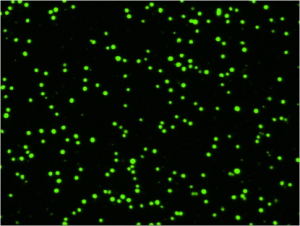
Membrane exclusion dyes, such as propidium iodide (PI), ethidium bromide (EB), and 7-AAD are frequently used to determine cell viability by staining non-viable nucleated cells with compromised membranes. These dyes are sometimes paired with acridine orange (AO), a dye that stains DNA in all nucleated cells to obtain total nucleated cell counts in complex cell samples. When AO and PI are combined it is possible to determine % viability for nucleated cells. When Calcein AM is used in conjunction with PI, it is possible to determine % vitality / viability based on the number of metabolically-active (green fluorescent) and non-viable (red fluorescent) cells in a sample. The Cellometer Vision and Vision CBA Image Cytometry Systems quickly and easily measure cell vitality / viability based on Calcein-AM / PI staining.
Because Calcein AM does not require DNA binding, it stains all metabolically-active cells and can be used to measure metabolic activity in non-nucleated cells, such as platelets. Calcein-AM is also a good alternative for analysis of adipocytes, as the AO dye has shown some non-specific binding of lipid droplets that does not occur with Calcein AM. Because Calcein AM is photostable, shows low cytotoxicity, does not affect cellular function, and requires cellular esterases for conversion to green fluorescing Calcein, it is a popular stain for the examination of cell vitality and viability (1,2,3).
- Braut-Boucher, F. et al. Journal of Immunological Methods. Vol. 178, Issue 41 (1995).
- Luc S. De Clerck. et al. Journal of Immunological Methods. Vol. 172, Issue 1, (1994).
- Parish, CR. Immunology and Cell Biology. Vol. 77 (1999)
- Verheul , HW. et al. Blood. Vol. 96 No. 13 (2000)
- Kilroy, G. et al. PLoS One. Vol.4, Issue 9 (2009)
- Akeson, AL. et al. J. Immunol. Methods. Vol. 163, Issue 181 (1993)






Leave A Comment